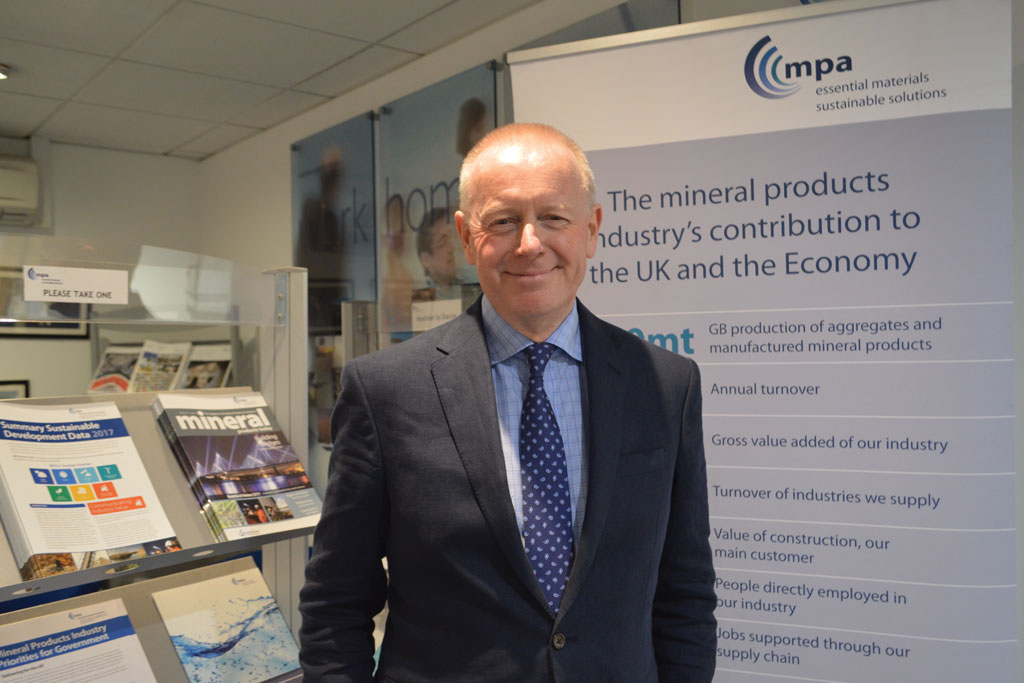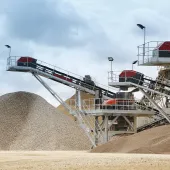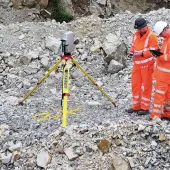Ten years on, MPA comes of age

First published in the March 2019 issue of Quarry Management
Driving change, raising standards, improving perceptions
By Nigel Jackson, chief executive officer, Mineral Products Association
In 2006, leaders in the industry acknowledged that a fragmented sector would be less likely to be effective in the years ahead, given the known challenges that were conceivable at that time. Little did they know then that within two years the economy would pivot from growth to recession and the era of austerity would arrive and endure. Nor could they have imagined the global banking crisis, the uprisings in the Middle East, the growth of populism in the West, the rise of Trump and, of course, the upheavals in Europe, of which Brexit remains the most uncertain.
The concept of uniting aggregates, cement and concrete into one trade association was not, of itself, an original thought, but finding the right moment with aligned leadership and equal determination to try was. It is to their credit that, after three years of evaluation and dialogue, on 3 March 2009 the MPA was formed by the union of the Quarry Products Association, British Cement Association and The Concrete Centre. One trade body now encompassing 14 product groups, covering cementitious materials (MPA Cement, BRMCA, MIA, MPA British Precast, The Concrete Centre, CSMA) and non-cementitious materials (MPA Aggregates, MPA Asphalt, MPA Dimension Stone, MPA Slag, ALA, BLA, BMAPA, SAMSA), many of them formerly independent trade associations in their own right, representing more than 90% of the UK mineral and mineral products industry worth £20 billion a year, and employing around 80,000 people directly and indirectly.
Simply put: one industry, one Board, one plan, one voice. More influence politically. More recognition of our industry’s essential contribution to the economy and our quality of life, as well as environmental and social progress. A concerted effort to help central government, local government and all other stakeholders ‘make the link’ to the role minerals and mineral products play in our lives.
Membership
Since inception, it has been heartening to see membership grow continuously over the last 10 years in all three membership categories, ie Producers, Associates and Affiliates. Membership now stands at more than 530 companies, up over 80% since 2009. The MPA now brings together England and its five Regional Groups, Wales and valued affiliates MPA Scotland and now MPA Northern Ireland under the same banner, reinforced by the non-producing Associate members and other valued affiliations with British Precast, the British Association of Reinforcement, the British Calcium Carbonates Federation, Eurobitume UK and, most recently, the UK Quality Ash Association.
This diverse and rich union provides an unrivalled breadth of expertise and commercial experience to draw upon in formulating industry policy positions and strengthening the Association’s commitment to our industry. It also substantially increases the role that industrial minerals play in the affairs of the Association. Membership interest continues and it is hoped that those very few remaining organizations that are as yet unaffiliated will feel able to do so over time.
Unity
If one factor has been the driver in building and strengthening the MPA, it has been unity. Even before ‘austerity’ government and key stakeholders were struggling to engage with a fragmented sector and that has not been made easier with the loss of both capacity and capability within both local and central government. Troubling as this is, it also creates an opportunity for a well-organized trade body to partially fill the spaces left behind, by collecting and presenting the evidence to underpin effective advocacy. Whilst government may listen to companies, as they should, they are unlikely to change regulation and legislation unless it takes account of the sectoral view, based on credible evidence. It is true to say that a company-level issue may trigger the recognition of the need for change, but the solution will need to be brokered sectorally.
Governance
Critical to building federal organizations is inclusion and balance, to ensure no party feels marginalized or ignored. This is particularly important when funding is asymmetric. The consolidated nature of the UK industry is an important reality, with comparatively few large international companies inevitably contributing the majority of the funding. The challenge for them is to avoid using this to dominate thinking or decisions.
Credit should be paid to those representatives of major funders who have acted with maturity and responsibility throughout the last 10 years and for resisting the temptation to leverage their financial muscle for selfish ends. They recognized that a high-performing and credible minerals sector benefits all companies, large, medium and small. With nearly 200 formal business meetings taking place across the MPA family each year, with literally hundreds of different and distinct voices ‘in play’, the idea of the few ruling the many is pretty much a non-starter in any event.
The MPA’s Council brings together the chairs of more than 20 product groups and core committees, typically involving 35 leaders who debate policy issues from the ‘bottom up’, en route to the MPA Board. A board which has 11 chief executive officers, representing a solid blend of majors and SMEs, ie Aggregate Industries, Allen Newport, Breedon Group, Brett Group, CEMEX, Day Group, Hanson, Marshalls, Morris & Perry, Singleton Birch and Tarmac. This is a truly representative board covering all mineral products interests throughout the UK. A strength of the board is the stability and corporate memory the SMEs provide, as international ownership of the largest companies inevitably means their representation changing every few years.
The operating imperative of such a board is building consensus such that no ‘power votes’ need to take place. In 10 years, no votes of this nature have either taken place or have ever threatened to take place. The strong and effective governance of the MPA is such that the board can act as the ‘controlling mind’ of the industry, whilst respecting that there are legitimate views expressed on a range of issues elsewhere. However, unlike others, the Association is uniquely placed to effect change at scale throughout the sector. It has been interesting to receive interest in the UK model from many other European countries and beyond, as elsewhere multiple trade associations typically exist by product group, locally, regionally and nationally.
MPA Charter
After the first five years in the evolution of MPA, the time had come to invite the membership to identify its vision for the next 10 years, its main strategic priorities, objectives and member commitments and targets. A two-year conversation with more than 50 companies led to the development of the MPA Charter, which enshrines seven main strategic priorities and 27 objectives underpinning the Association’s main aims, ie:
- Economic conditions that support investment
- Better government support for an essential industry
- A reasonable licence to operate
- Proportionate legislation and regulation
- Recognition of progress
The Charter provides the framework for both the budget and workstreams in order to help the Vision for 2025 to be achieved. Conformity with the Charter is growing and, as external pressures mount on the industry to further demonstrate its social and environmental responsibility, this will provide the platform for the membership to show its commitment.
Three-yearly external stakeholder surveys show that, whilst opposition remains locally when new planning applications are made for quarries, extensions, or added-value activities such as ready-mixed concrete or asphalt plants, rail depots and wharves, at a national and representative level the Association and the sector it represents is thought of positively and its outputs valued. The industry’s growing transparency and accountability is recognized and appreciated and helps create a more positive perception than regressing to the inward-looking attitudes that often existed 20 years ago. MPA investment in social media may be playing a role, with its five Twitter channels attracting 25,000 followers and its YouTube channel attracting 320,000 views, all helping to promote the essential contribution of our industry and showcasing best practice and the high levels of operating excellence that are being achieved.
The span of issues facing the industry increases continuously, as does the degree of complexity. Global issues are now influencing local development and the industry has to respond in a far more responsible, integrated and professional way, if it is to retain its ‘licence to operate’ and build trust with local communities.
Health and Safety
The rigorous and consistent collection and sharing of performance data over the last 10 years has helped paint a mixed picture of sector performance. Although there remain too many fatalities and lost-time incidents, progress has been made in reducing incidents and improving incident rates. But a particularly tragic 2017 did ‘reset the agenda and change the conversation’ to focus on the six potential high-consequence hazards (‘the Fatal 6’: Contact with Moving Machinery and Isolation; Workplace Transport and Pedestrian Interface; Work at Height; Respirable Crystalline Silica; Struck by Moving Falling Object; and Road Traffic Accidents) which require determined focus to mitigate the main risks. Strategic websites such as Safequarry and Safeprecast, and their Apps, act as industry portals to help gather and share best practice and incident alerts quickly and effectively.
Industry commitment to achieving Zero Harm remains, but as time goes by and the plateauing effect emerges, from time to time the difficulty of the challenge seems to increase. Industry leadership is the key to further progress both within and beyond the MPA, as will be the evolution from lagging to leading indicators. Improved co-operation with other trade bodies and professional and training organizations will also contribute to the shift in cultural thinking and behaviour that is known to be necessary in all parts of the wider industry, and MPA participation in the Mineral Products Qualification Council (MPQC) and the Strategic Health & Safety Forum for mineral products can help fulfil this ambition.
But health and safety issues are not just confined to the quarry and plants. Increasingly, public safety issues at disused sites, on our roads and transport network, and around other production and delivery sites, are demanding far greater industry engagement. Equally, an increased focus on health and, most recently, mental health has been long overdue. The MPA’s championing of ‘Mates in Mind’ is playing its part in ‘starting conversations’ that will hopefully help change this aspect of the sector’s culture. Air-quality issues are also testing the industry, given the many interwoven technical issues that this encompasses. The MPA’s Stay Safe and Cycle Safe campaigns and engagement with key stakeholders, such as the National Inland Water Safety Forum, Transport for London and RoSPA, have proved key in influencing stakeholder awareness and co-operation in these important areas.
Planning and permitting
The cumulative costs and impacts of planning and permitting generate as much angst amongst companies as ever. The MPA has gripped these issues hard over the years, evidencing the flawed nature of the ‘plan-led’ system and planning process, with its Annual Mineral Planning Surveys (AMPS) and reports and forecasts of future demand and the need for aggregates and other minerals and mineral products. This work has contributed to the retention of a National Planning Policy Framework which is largely supportive of the industry, as well as the Managed Aggregate Supply System (MASS), albeit without adequate resource or process to support it.
Increasingly, the Association is becoming the authoritative source of evidence that government once was. The recognition of the role of the mineral products sector and the significance of its supply chains within the Government’s Industrial Strategy and Construction Sector Deal is a key advance lobbied for by the MPA. The recognition of the need for safeguarding of vital infrastructure such as wharves and rail depots with the National Infrastructure Commission and in the London Plan has also been hard fought and provides evidence that some regulators are beginning to ‘make the link’. These are all important dynamics that affect companies’ ‘licence to operate’ and, in turn, their ‘licence to market’. The MPA is on a mission to ensure that no policymaker or influencer ‘can assume supply’.
Design codes and technical standards
An area of Association activity which receives too little attention or appreciation is that related to the development and maintenance of design codes and product technical standards. Behind all product groups lies an expert technical standards community, who jointly protect UK companies’ ability to ‘place products on the market’, influencing not just British Standards but European Standards through our involvement in the numerous high-demand CEN committee processes. The Association invests heavily in standards development with around 100 individual company experts working with MPA staff to ensure practical world-class standards that are fit for purpose and enable a level playing field with fair competition through the supply chain. Equally, design codes which govern the choice of materials and their application in the built environment can have a direct impact on the demand for concrete. MPA The Concrete Centre plays a critical role in ensuring that designers and specifiers are able to make informed design decisions. This work will increase in significance post-Brexit, whichever trading model emerges.
Carbon and climate change
The Association is fortunate to have a highly qualified expert team in the field of carbon management, taxation and emissions. The cement, industrial lime and asphalt industries are all energy intensive and caught by any number of carbon-trading and regulatory systems, which increase the tax burden on UK businesses and supply chains. Concerted and intense effort has been expended over the last 10 years, both in liaison and competition with other energy-intensive industries, to protect the industrial competitiveness of our products in a world where the impacts by sector are becoming more widely recognized and mitigating actions expected. As the carbon footprints of industrial processes become more transparent and better understood, the industry is having to work harder in demonstrating the whole-life benefits of its product offer and carbon-reduction pathways.
Concrete and asphalt in the built environment
With the transition to a low-carbon economy, an embedded aim of all political parties, together with the ambition to build more homes and more quickly, means that a number of public policy issues begin to collide, ranging from understanding both embedded and whole-life carbon footprints, to off-site and modern methods of construction. MPA The Concrete Centre, with its experienced architects and civil engineers, has built a
10-year evidenced track record of the industry’s environmental and sustainability work to push back on rival materials such as timber, which, in comparison, is given a very soft ride by government. Whilst the MPA has no rooted objection to modern methods of construction, particularly with our precast concrete members being so active, we continue to fight for an ‘on merits’ approach to decisions regarding the choice of materials in design. No other industry group is equipped or able to support its members in this increasingly contested area of public policy.
The MPA’s joint venture with Eurobitume, the Asphalt Industry Alliance, has successfully exposed the shocking and continuous scourge of underfunding local authority road maintenance over the years. The era of the pothole has reinforced the evidence of the annual ALARM survey of local authorities to highlight the need for more investment in this vital part of UK infrastructure.
Sustainable development
All of us in this great industry know that we have a great story to tell. Ten years ago, we had made limited progress in telling it:
10 years on, we have made greater progress. Four annual Sustainable Developments reports, covering lime, marine aggregates, cement, concrete and the MPA as a whole, consolidate the positive environmental and social achievements of the industry. These are vital in converting assertion into evidence and influence. The context of this progress is woven into a wider perspective and broader story in other publications such as Mineral Products Today and Concrete Quarterly, which reach parliamentarians, officials, county councillors and environmental groups.
Biodiversity and ‘Quarries & Nature’
What was once just an issue of restoration of quarries has developed into a stronger and front-foot issue for the sector, as pressures on UK biodiversity grow and the positive role that the industry can play in achieving Professor Lawton’s idea of ‘bigger, better and more joined-up’ environments evolves. This has helped the MPA consolidate companies’ individual biodiversity achievements into a virtual ‘National Nature Park’, networking 100 separate sites across the UK to build on the Association’s still unique Biodiversity Strategy launched in 2009. The biennial MPA Restoration & Biodiversity Awards, in partnership with Natural England, has also helped to showcase the range of innovative improvements companies are making across the UK as they restore land and create ‘net gain’. Valued partnerships and MOUs with the Bumblebee Conservation Trust, the Bats Conservation Trust and the Freshwater Habitats Trust all help raise the industry’s responsible profile and highlight the significant contribution it is making to UK biodiversity. Recognition by key NGOs such as the Wildlife Trusts and RSPB, who have worked constructively with the industry on Nature After Minerals and cited quarry restoration positively in their ‘State of Nature’ report, is welcomed.
European links
Notwithstanding Brexit, the MPA has and will maintain valued membership of 12 European trade associations, such as the European Aggregates Association, UEPG, (which will hold its next delegates assembly in London this year, hosted by the MPA), Cembureau, EuLA, EAPA, IMA, ERMCO, EMO, and BIBM, amongst others. These links are vital to help benchmark, share and receive best practice and ensure that pressure across Europe on the need for minerals and mineral products is given prominence and force as well as influencing European regulation.
Leadership and collaboration
The MPA values its membership of other key industry associations such as the CBI and CPA, where influence on all business and the wider construction industry is possible. Active leadership, by chairing the long-running CBI Minerals Group and facilitating the development of the UK Minerals Strategy with other valued partners in the group who together nurture the UK Minerals Forum, is also important in presenting a more unified face and voice to planners, regulators and NGOs. Participation in many other fora and other key alliances, such as the Energy Intensive Users Group and the increasingly influential Construction Leadership Council and Global Cement and Concrete Association, testify to how demanding the theatre of operation has become both locally and internationally.
The next 10 years
The MPA Charter was developed to identify the Vision for the industry until 2025. It is ambitious and will only be achieved with a united sector represented by an effective trade association working with key partners. The work of the MPA over the last 10 years may have helped meet the challenges throughout this period, but it will not be good enough just to stand still and hope that what worked historically will work going forward. The MPA is reviewing its operating model and resourcing to ensure it is fit for purpose for the next 10 years. Previous issues have been more ‘siloed’, but in recent years we have seen a transition into issues which cut across both product segments and policy functions. An even more integrated and holistic approach needs to be developed. That is not simple to do. Recognizing that this is necessary is, however, one of the most important conclusions that needs to made and acted upon.
What was once a simple long-term industry, that takes minerals from the ground and converts them into product to serve markets, has changed. Global issues are connecting to local developments and a more connected and informed populace knows how to make its voice heard. Complex, fast-moving issues fuelled by assertion, emotion and often ‘fakism’ are a reality that must be confronted. The industry must stay true to its practical core, stay steady, maintain its evidence and, above all, stay united and fit for a changing and more demanding purpose. Any regression into a fragmented and parochial approach would unravel the proven progress to date and make it less likely that demand can be met by sustainable supply. Supply cannot be assumed, nor can unity. It needs leadership and rigorous and continuous hard work. The MPA remains committed to enabling the industry to be the best it can be. Driving change, raising standards, improving perceptions.
- Subscribe to Quarry Management, the monthly journal for the mineral products industry, to read articles before they appear on Agg-Net.com








